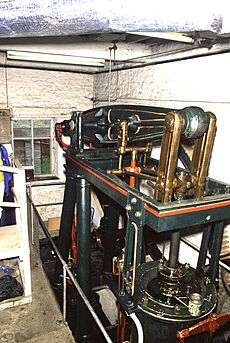Combe Mill facts for kids
Quick facts for kids Combe Mill |
|
|---|---|
 |
|
| Type | Sawmill |
| Location | Long Hanborough |
| OS grid reference | SP 41660 15041 |
| Area | Oxfordshire |
| Built | 1852 |
| Governing body | Combe Mill Society |
| Owner | Blenheim Palace Estate |
|
Listed Building – Grade II*
|
|
| Official name: Combe Mill | |
| Designated | 29 June 1988 |
| Reference no. | 1053004 |
| Lua error in Module:Location_map at line 420: attempt to index field 'wikibase' (a nil value). | |
Combe Mill is a really old sawmill located next to the River Evenlode. You can find it near Combe railway station, between the villages of Combe and Long Hanborough in Oxfordshire, England. This special building is protected as a Grade II* listed building, which means it's very important historically. It was fixed up in the early 1970s and is now open for everyone to visit.
Contents
The Mill's Story: How It Began
Combe Mill was built in 1852. It was made to be the main workshop for the huge Blenheim Palace Estate. Before this, there was an older flour mill from the 1600s on the same spot. That old mill was sold to George Spencer, 4th Duke of Marlborough in 1766.
At first, the mill used a big waterwheel for power. This wheel turned by the force of the river. But sometimes the river didn't have enough water. So, in 1886, a beam engine and a special Cornish boiler were added. These allowed the mill to keep working even when the river was low. The steam engine stopped working around 1922 and sat unused for many years.
In 1934, the old wooden waterwheel was replaced with a new metal one. The main shaft was also replaced with the timber one you see today. For about 40 years, the waterwheel was the mill's main power source. However, during World War I, the government took over the mill. They installed extra steam engines. The mill was used to make wooden props and duck-boards for soldiers in the battlefield trenches.
By the 1950s, electricity came to the mill. This made the waterwheel less important. It stopped being used in the mid-1960s. The water channel, called a leat, was filled in, and the sluices (water gates) were buried.
Bringing the Mill Back to Life
In 1969, a group from the City and County Museum in Woodstock looked at the mill. They started talking with the Duke of Marlborough about fixing the old beam engine and boiler. It was a big success! In September 1972, the engine ran on steam for the first time in 60 years.
After this, the Combe Mill Society was created. The mill officially opened to the public in 1975. Since then, many other parts of the mill have been carefully restored.
Inside the mill, you can still see old trade catalogues. These books show the tools and parts that were once ordered for the estate. There are also old day books from the mid-1800s. These books list the workers' names, how much they earned, and what jobs they did each day.
Visiting Combe Mill Today
Combe Mill is open to visitors from March to October. On the third Sunday of these months, you can see the mill "in steam." This means the old steam engine is running! Schools and other groups can arrange special visits at any time. The mill also has a working forge. Here, visitors can even try making their own fireplace pokers!
External links
- Combe Mill website


